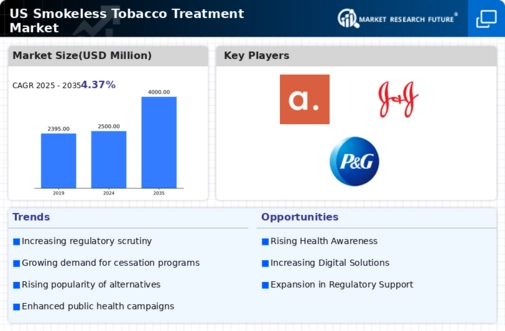Supportive Government Policies
Supportive government policies aimed at reducing tobacco use are significantly influencing the smokeless tobacco-treatment market. Legislative measures, such as increased taxes on tobacco products and restrictions on advertising, have been implemented to discourage usage. The US government has allocated substantial funding for tobacco cessation programs, which has resulted in a marked increase in the availability of treatment resources. For instance, the CDC reported that states spent over $500 million on tobacco prevention and cessation programs in 2020. Such initiatives not only promote awareness but also provide financial support for individuals seeking to quit, thereby driving growth in the smokeless tobacco-treatment market.
Increased Focus on Mental Health
The increased focus on mental health and its connection to tobacco use is influencing the smokeless tobacco-treatment market. Many individuals use smokeless tobacco as a coping mechanism for stress, anxiety, or depression. As mental health awareness rises, there is a growing recognition of the need for integrated treatment approaches that address both mental health and tobacco dependence. Programs that incorporate behavioral therapy alongside cessation methods are gaining traction. This holistic approach not only aids in quitting but also supports overall mental well-being. The smokeless tobacco-treatment market is likely to benefit from this trend as more comprehensive treatment options become available.
Growing Awareness of Health Risks
The increasing awareness of the health risks associated with smokeless tobacco use is a primary driver for the smokeless tobacco-treatment market. Public health campaigns and educational initiatives have highlighted the potential dangers, including oral cancers and cardiovascular diseases. As a result, more individuals are seeking treatment options to quit smokeless tobacco. According to the Centers for Disease Control and Prevention (CDC), approximately 3.5 million adults in the US use smokeless tobacco, and many are motivated to quit due to health concerns. This growing awareness is likely to propel the demand for cessation programs and treatments, thereby expanding the smokeless tobacco-treatment market.
Rising Popularity of Alternative Therapies
The rising popularity of alternative therapies for smoking cessation is emerging as a notable driver in the smokeless tobacco-treatment market. Many individuals are exploring holistic approaches, such as acupuncture, hypnotherapy, and herbal supplements, as adjuncts to traditional treatment methods. This trend reflects a broader shift towards personalized healthcare, where patients seek tailored solutions for their cessation journey. The integration of these alternative therapies into existing treatment frameworks may enhance the effectiveness of quitting strategies, potentially leading to higher success rates. Consequently, this growing interest in diverse treatment options is likely to stimulate demand within the smokeless tobacco-treatment market.
Technological Integration in Treatment Solutions
Technological integration in treatment solutions is becoming a pivotal driver for the smokeless tobacco-treatment market. The advent of mobile applications, online support groups, and telehealth services has transformed how individuals access cessation resources. These technologies provide users with personalized support, tracking tools, and real-time feedback, making the quitting process more manageable. A report from the National Institute on Drug Abuse indicates that digital interventions can increase the likelihood of successful cessation by up to 30%. As technology continues to evolve, its role in enhancing treatment efficacy and accessibility is expected to expand, thereby propelling growth in the smokeless tobacco-treatment market.














Leave a Comment